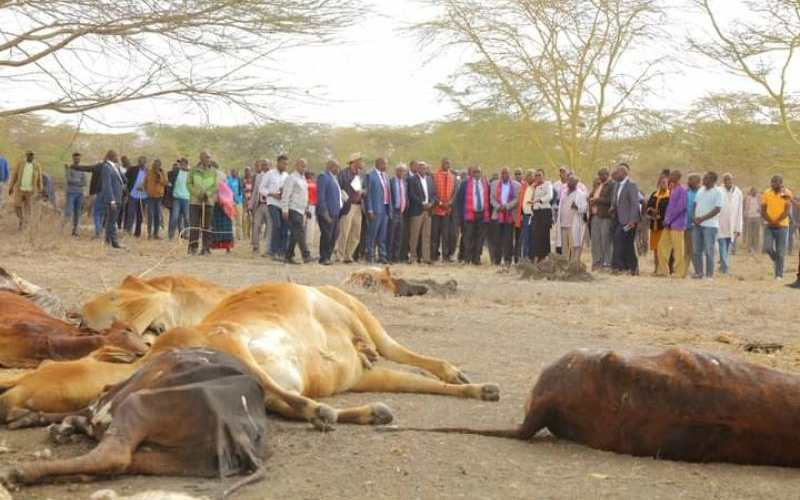
Agriculture CS Mithika Linturi overseeing effects of drought in Kajiado.[File, Standard]
More than 900,000 children below five years are malnourished as a result of the ongoing drought, the National Drought Management Authority (NDMA) has said.
The Authority noted that there are 134,000 pregnant or lactating women who are acutely malnourished and in need of treatment.
This comes on the back of a worsening drought situation in Kenya, with widespread loss of livelihoods.
In a statement released on Monday, NDMA noted that the number of counties in the drought alarm phase has risen from 10 to 14.
As a result, the drought situation has now affected about 4.4million Kenyans who lack basic meals in Arid and Semi-arid (ASAL) areas while another 846,000 people in non-ASAL counties face a similar issue.
"The number of counties in the alarm phase of drought has increased from 10 to 14. These counties are Laikipia, Marsabit, Garissa, Isiolo, Kilifi, Kwale, Samburu, Tana River, Tharaka Nithi, Turkana, Wajir, Kitui, Kajiado and Mandera."
"Seven counties namely Embu, Narok, Taita Taveta, Makueni, Meru, Nyeri and Lamu are in the alert drought phase," the Authority said.
Experts have attributed the worsening situation to "four failed seasons and the late onset and poorly distributed 2022 short rains season."
"Another 846,000 people in pockets of nine non-ASAL counties are adversely affected."
Although some areas have received rainfall, experts say recovery will take months. Instead, they have called for scaled-up and sustained response efforts.
According to NDMA, diminishing resources have led to conflicts in some areas, while livestock keepers have been forced to migrate in others, a factor that has enhanced livestock mortalities.
National and County governments have spent about Sh22 billion in drought interventions.
As a result, the drought situation has now affected about 4.4million Kenyans who lack basic meals in Arid and Semi-arid (ASAL) areas while another 846,000 people in non-ASAL counties face a similar issue.
"The number of counties in the alarm phase of drought has increased from 10 to 14. These counties are Laikipia, Marsabit, Garissa, Isiolo, Kilifi, Kwale, Samburu, Tana River, Tharaka Nithi, Turkana, Wajir, Kitui, Kajiado and Mandera."
"Seven counties namely Embu, Narok, Taita Taveta, Makueni, Meru, Nyeri, and Lamu are in the alert drought phase," the Authority said.
Experts have attributed the worsening situation to "four failed seasons and the late onset and poorly distributed 2022 short rains season."
"Another 846,000 people in pockets of nine non-ASAL counties are adversely affected."
Although some areas have received rainfall, experts say recovery will take months. Instead, they have called for scaled-up and sustained response efforts.
According to NDMA, diminishing resources have led to conflicts in some areas, while livestock keepers have been forced to migrate in others, a factor that has enhanced livestock mortalities.
National and County governments have spent about Sh22 billion on drought interventions.
 The Standard Group Plc is a multi-media organization with investments in media
platforms spanning newspaper print
operations, television, radio broadcasting, digital and online services. The
Standard Group is recognized as a
leading multi-media house in Kenya with a key influence in matters of national and
international interest.
The Standard Group Plc is a multi-media organization with investments in media
platforms spanning newspaper print
operations, television, radio broadcasting, digital and online services. The
Standard Group is recognized as a
leading multi-media house in Kenya with a key influence in matters of national and
international interest.









